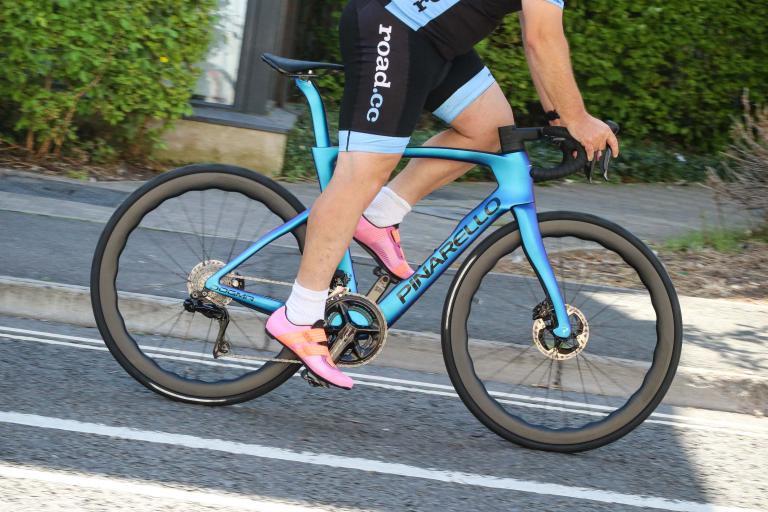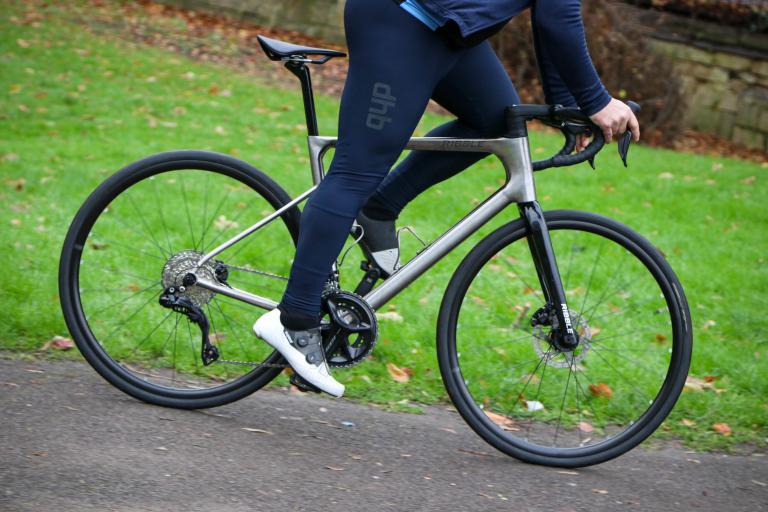- News
- Reviews
- Bikes
- Accessories
- Accessories - misc
- Computer mounts
- Bags
- Bar ends
- Bike bags & cases
- Bottle cages
- Bottles
- Cameras
- Car racks
- Child seats
- Computers
- Glasses
- GPS units
- Helmets
- Lights - front
- Lights - rear
- Lights - sets
- Locks
- Mirrors
- Mudguards
- Racks
- Pumps & CO2 inflators
- Puncture kits
- Reflectives
- Smart watches
- Stands and racks
- Trailers
- Clothing
- Components
- Bar tape & grips
- Bottom brackets
- Brake & gear cables
- Brake & STI levers
- Brake pads & spares
- Brakes
- Cassettes & freewheels
- Chains
- Chainsets & chainrings
- Derailleurs - front
- Derailleurs - rear
- Forks
- Gear levers & shifters
- Groupsets
- Handlebars & extensions
- Headsets
- Hubs
- Inner tubes
- Pedals
- Quick releases & skewers
- Saddles
- Seatposts
- Stems
- Wheels
- Tyres
- Health, fitness and nutrition
- Tools and workshop
- Miscellaneous
- Tubeless valves
- Buyers Guides
- Features
- Forum
- Recommends
- Podcast
review
£649.99
VERDICT:
Lightweight performance at a very reasonable price
Weight:
7,680g
Contact:
www.kinesisbikes.co.uk
At road.cc every product is thoroughly tested for as long as it takes to get a proper insight into how well it works. Our reviewers are experienced cyclists that we trust to be objective. While we strive to ensure that opinions expressed are backed up by facts, reviews are by their nature an informed opinion, not a definitive verdict. We don't intentionally try to break anything (except locks) but we do try to look for weak points in any design. The overall score is not just an average of the other scores: it reflects both a product's function and value – with value determined by how a product compares with items of similar spec, quality, and price.
What the road.cc scores meanGood scores are more common than bad, because fortunately good products are more common than bad.
- Exceptional
- Excellent
- Very Good
- Good
- Quite good
- Average
- Not so good
- Poor
- Bad
- Appalling
If you're looking for a new race steed that won't leave you with moths in your pockets, you could do a lot worse than Kinesis' new Alu/Carbon road platform, the KR510. There's plenty of good technology crammed in, and Kinesis' reputation of producing high quality frames at a decent price looks to be safe with this one.
The KR510 is built from 7005 aluminium alloy using SPF techniques. Que? SPF is Superplastic Forming technology and it’s used to shape the top tube, down tube and seat tube. Unlike hydroforming, where high-pressure hydraulic fluid is used to mould the metal, SPF uses pressurized gas. Kinesis reckon this allows them to produce more complex and lighter tubing.
There’s certainly a whole lot of tube shaping on display here. The top tube is a… crikey, it’s hard to describe. It’s almost triangular in cross-section except that the top face is actually three different faces and the other two sides are curved. Not at all triangular really, then. It tapers considerably as it slopes downward towards the seat tube junction.
The down tube has a teardrop profile up front but it morphs into a triangle (really this time) by the time it reaches the bottom bracket, while the seat tube, though mostly round, extends backwards through its mid-section to curve around the rear wheel in a semi-aero kind of a way. Out back you get wishbone carbon fibre seatstays that plug in just behind the seat tube and replaceable dropouts to reduce the chances of a drivetrain mishap ruining your entire frame. The welds are pretty smooth and the painted finish is neat too.
There’s nothing too strange about the geometry. Our large 56cm model (measured from the centre of the bottom bracket to the top of the seat tube) came with a 57cm effective top tube, a 17cm head tube and 72.75°/73° frame angles.
The fork is Kinesis’ new RC05 which comes with deep-section carbon legs, an aluminium steerer and machined dropouts, while a Cane Creek-manufactured headset and an alloy seat clamp complete the package.
You can build up the KR510 frame however you like, but ours came with components mostly from Kinesis distributors Upgrade: Reynolds Solitude wheels and Vittoria tyres, Oval bar and stem, TRP brakes. The gearing is provided by Campagnolo’s Centaur groupset.
The first thing you notice about the KR510 is the weight. The complete bike (without pedals) hits the scales at 7.68kg – or 16.9lb in old money. The frameset comes in at around 1.5kg (3.3lb). That’s seriously impressive for a bike of this price. And if you wanted to reduce the all-up grammage some more, you could easily spec lighter kit; for example, the deep Reynolds Solitude rims are built to be aerodynamic more than featherweight.
Happily, the light weight doesn’t come at the expense of frame stiffness, and this is a bike that jumps into life when you climb aboard and bang out the power. There’s minimal flex through the centre section even when you’re riding out of the saddle – no noticeable twisting here. And that lack of weight is a real advantage when you hit the hills, helping to keep your climbing that little bit livelier.
The fork performs well too. The legs are skinny enough to really cut through the air but they’re taut enough to stay straight when you throw the bike around tight downhill bends and they behave when you slam on the brakes. We like.
The Kinesis is a winner in terms of comfort too. Most people will get on fine with the mid-height front end and a bunch of headset spacers will offer plenty of scope for adjustment. There’s enough twang in the frame and forks to smooth out uneven road surfaces without you getting too jolted and jarred, helping you stay fatigue-free during long rides. A comfy perch like our Fizik Arione is obviously good news there too.
Do the carbon fibre seatstays bring much to the party? Probably not. We’ve never thought they add much in terms of ride quality. But, hey, they look cool and that’s worth something.
Verdict
Lightweight performance at a very reasonable price. The KR510 is a very light frame for the money and could easily be the basis of a 16lb race bike with the right kit. For £649 it's a definite contender for your cash,
road.cc test report
Make and model: Kinesis KR510 SPF
Size tested: L
About the bike
State the frame and fork material and method of construction. List the components used to build up the bike.
The frame is 7005 aluminium alloy with carbon fibre wishbone seatstays. Kinesis make much of the SPF - SuperPlastic Forming - technology used to shape the top tube, down tube and seat tube.
With hydroforming, a high pressure hydraulic fluid is used to press the metal into a mould at room temperature.
SuperPlastic Forming is done at high temperatures so the metal is more malleable. This allows Kinesis to shape the tubes more and keep the weight down – and it's much cheaper than carbon fibre.
The fork is carbon-bladed with an alloy steerer and machined dropouts.
Tell us what the bike is for, and who it's aimed at. What do the manufacturers say about it? How does that compare to your own feelings about the bike?
Kinesis say, "This is an ideal basis for a super fast crit or club racer that won’t break the bank."
We'd agree: it's a performance-orientated road machine, so you could use it for racing, fast weekend rides, sportives and so on.
Frame and fork
Overall rating for frame and fork
8/10
Tell us about the build quality and finish of the frame and fork?
The welds are smooth and tidy and the paintjob is neat too. No complaints there.
Tell us about the geometry of the frame and fork?
The angles vary according to the frame size - our 56cm model has a 72.75° head angle and a 73° head angle.
How was the bike in terms of height and reach? How did it compare to other bikes of the same stated size?
It's a fairly standard road bike in terms of sizing.
Riding the bike
Was the bike comfortable to ride? Tell us how you felt about the ride quality.
Yes, it's comfortable enough. The ride position isn't too extreme and the frame and forks take the edge off vibration from the road surface.
Did the bike feel stiff in the right places? Did any part of the bike feel too stiff or too flexible?
The bottom bracket stays firmly in position even when you crank up the power and the fork tracks well.
How did the bike transfer power? Did it feel efficient?
Yes. You don't get the feeling that any of your effort is being wasted.
Was there any toe-clip overlap with the front wheel? If so, was it a problem?
A tiny amount but not a problem
How would you describe the steering? Was it lively, neutral or unresponsive? Neutral
Rate the bike for efficiency of power transfer:
8/10
Rate the bike for acceleration:
8/10
Rate the bike for sprinting:
8/10
Rate the bike for high speed stability:
8/10
Rate the bike for cruising speed stability:
8/10
Rate the bike for low speed stability:
8/10
Rate the bike for flat cornering:
8/10
Rate the bike for cornering on descents:
8/10
Rate the bike for climbing:
8/10
Did you enjoy riding the bike? Yes, it's lively and responsive - good fun to ride
Would you consider buying the bike? There are a lot of lightweight alu road bikes out there but this one does enough to make it onto your list of potentials
Would you recommend the bike to a friend? Yes
About the tester
Age: 36 Height: 184cm Weight: 74kg
I usually ride: My best bike is:
I've been riding for: Over 20 years I ride: Most days I would class myself as: Expert
I regularly do the following types of riding: time trialling, commuting, sportives, general fitness riding, mtb,
Mat has been in cycling media since 1996, on titles including BikeRadar, Total Bike, Total Mountain Bike, What Mountain Bike and Mountain Biking UK, and he has been editor of 220 Triathlon and Cycling Plus. Mat has been road.cc technical editor for over a decade, testing bikes, fettling the latest kit, and trying out the most up-to-the-minute clothing. He has won his category in Ironman UK 70.3 and finished on the podium in both marathons he has run. Mat is a Cambridge graduate who did a post-grad in magazine journalism, and he is a winner of the Cycling Media Award for Specialist Online Writer. Now over 50, he's riding road and gravel bikes most days for fun and fitness rather than training for competitions.






















There's no end to their failure....
Full details here DA and Ultegra cranksets manufactured June 2012-July 2019, all serial numbers on the link. Take the bike to a participating...
I'm not sure I agree with the totality of the conclusions of this piece, but do agree with many points on costly kit. There is no difference in...
Nah. I would just make the bike have more resistance. Like, bearings that have high resistance in the wheels for example. Banning anything aero I...
Looks a very interesting frame... could be perfect for scooting along the goat tracks we call b-roads in the UK...
Ah! The peening tool...
and long may it continue.
Joey Baptiste pleads guilty over Ferrari crash in Norwich...
I'm just giving some context so that the argument you make can be made. I'm also on your side so tone down the "... , have you?" attitude at the...
Interesting point! Thanks for bringing that one up Rendel.